Growing black-eyed Susan from seed is easy, even for a novice gardener. It is not hardy, but thanks for a sunny location with a large abundance of flowers.

Black-eyed Susanne is a lush flowering climber and belongs to the genus Thunbergia. This was named after the famous Swedish botanist Thunberg. It is the most commonly cultivated species with the most cultivars and is given the botanical name Thunbergia alata designated. When the black-eyed Susan flowers, how best to propagate and which ones Thunbergia-Types there are, we explain here.
contents
-
Black-eyed Susan: flowering period and characteristics
- Is black-eyed Susanne perennial?
- Is Black-Eyed Susan Bee-Friendly?
- The most beautiful types and varieties
- Is black-eyed Susanne hardy?
-
propagation
- Propagation via cuttings
- Propagation via seeds
- Is black-eyed Susan poisonous?
Black-eyed Susan: flowering period and characteristics
The genus Thunbergia
, also known as heavenly flowers, belongs to the acanthus family (Acanthaceae) and is native to Southeast Africa. The most popular species in our gardens is the Black-eyed Suzanne, colloquially known as Black Suzanne or One-eyed Suzanne. It owes its German name to its flower structure. The funnel-shaped base is dark colored on the inside and makes the flat corolla appear with a dark "eye". The wild type of black-eyed Susanne forms orange-yellow flowers, although cultivated forms can also have other flower colors. The leaves are heart-shaped and serrated at the edge.The Black Susanne is particularly popular with hobby gardeners because of its rapid and luxuriant growth, which allows it to climb a full 2 to a maximum of 3 m. You can let the climbing plant grow upwards on house walls with trellises or sticks or use it as a magnificent hanging plant in hanging baskets and flower boxes. Black-eyed Susans bloom between June and September.

Is black-eyed Susanne perennial?
Yes, Black-eyed Susan is actually a perennial. With us, however, it is often cultivated as an annual, as it loses its willingness to grow after the second year. Because of their declining vitality, annual new sowing is recommended.
Is Black-Eyed Susan Bee-Friendly?
Bees are hardly observed on the black-eyed Susanne. Nevertheless, it is an important food source for insects such as butterflies and bumblebees, which reach the nectar at the base of the flower with their longer proboscis. It is not without reason that it is one of our most popular insect-friendly climbing plants for the garden.
The most beautiful types and varieties
The wild species of black-eyed susan has orange-yellow flowers, although it is worth getting to know other varieties with different flower colors:
- Thunbergia alata 'African Sunset' is characterized by its multicolored shaded flowers. With this variety you can look forward to yellow, orange and dark red tones in one flower.
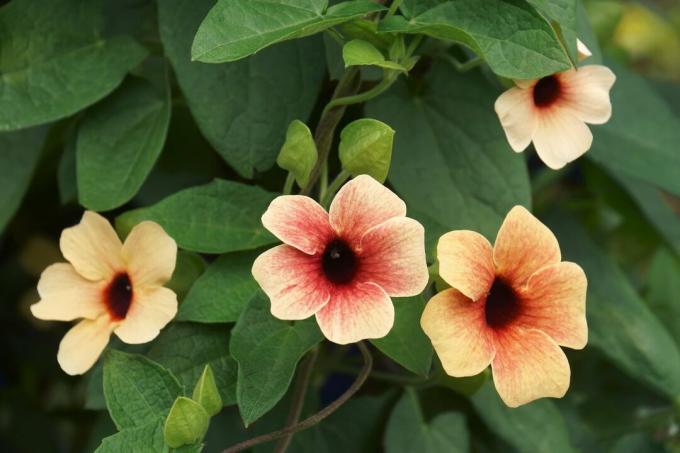
- Thunbergia alata 'Arizona Rose Sensation' is slow-growing and enchants with its bright pink flowers.
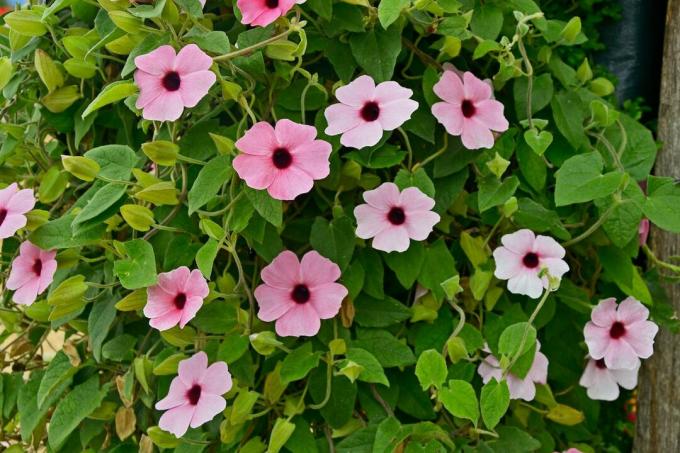
- Thunbergia alata 'Alba' beautifies the garden with bright white flowers and is one of the slow-growing varieties.
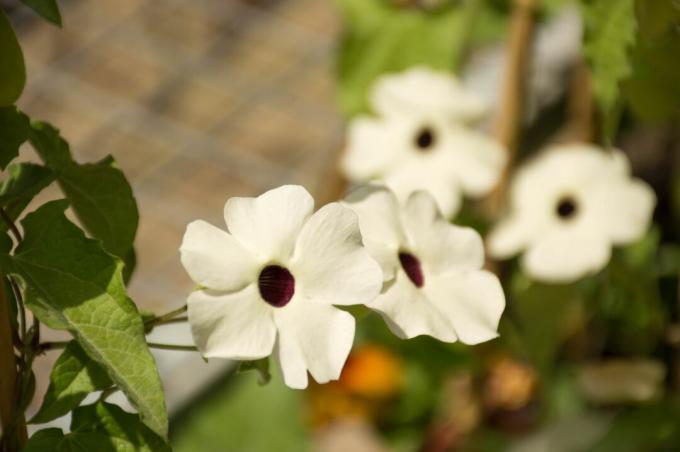
Next to Thunbergia alata there are more Thunbergia-Species that are very popular in gardens:
- Thunbergia gregorii stands out with its bright orange flowers without a black eye in the middle. The wild form reaches a height of 3 m, cultivated forms up to 5 m. Like its relatives, it thanks a sunny location Thunbergia alata with lots of flowers.

- Thunbergia grandiflora is also known as the sky flower and owes its name to its large, blue flowers. It loves a sunny to semi-shady place and reaches a height of 5 m.

Is black-eyed Susanne hardy?
No, the black-eyed Susanne is not hardy and very sensitive to frost. Due to its originally African origin, it is used to warm temperatures. At temperatures below 8 °C their shoots die off. If you want to overwinter the black-eyed Susanne, there are a few things to consider. It is assumed that the plant has been cultivated in a tub or pot in order to be able to move it to a suitable location.
Before doing this, cut off all the shoots 5 cm above the ground. Black-eyed Susanne does not like it too warm in winter, which is why a temperature of 10 to 15 °C must be guaranteed in the winter quarters. Also make sure they are in a bright location and avoid waterlogging. It does not need to be fertilized during the winter months.
In the spring, after the last frost, the climbing plant can be brought outside again. If these conditions cannot be met, there is no need to worry as black-eyed susan is easy to propagate and seed.
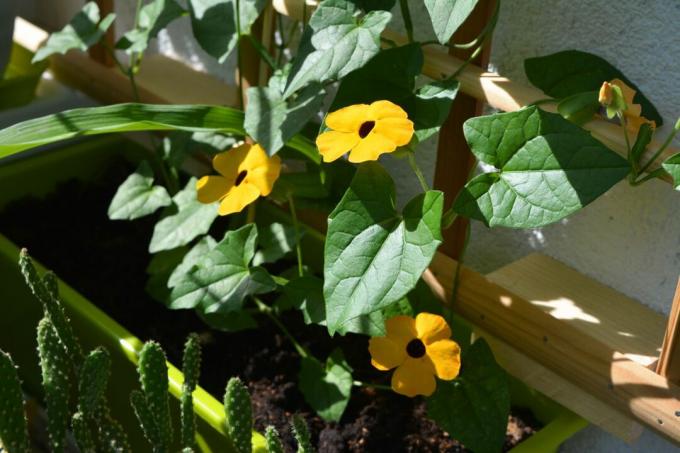
propagation
There are 2 ways to multiply the black-eyed Susanne - one by cuttings and one by generative propagation, i.e. seeds.
Propagation via cuttings
- Select young, green shoots
- Take cuttings in late summer/autumn
- Leave at least 3 upper pairs of leaves on the shoots, remove the remaining leaves
- Put the cuttings individually in small pots with growing substrate
- Choose a bright and comparatively warm location between 15 and 20 °C
- Cover the cuttings with foil to avoid heavy transpiration
- Keep the substrate moist, but never wet
Since the roots of the cuttings that are still growing cannot utilize an excess of nutrients, a low-nutrient seed soil is suitable for the cultivation. Our Plantura Organic Herb & Seed Soil offers the cuttings no more and no less than the necessary nutrients and can also be used for sowing young plants. In addition, it is peat-free and consists of 100% natural raw materials, which is why CO2 is saved. If the cutting forms new leaves, this is a sign of successful rooting. Now you can start pricking out the black-eyed Susan and plant 3 to 5 plants together, depending on the pot size.

Plantura Organic Herb & Seed Soil
Organic, peat-free & climate-friendly:
For aromatic herbs and for
successful sowing, cuttings
propagation & for pricking out
Propagation via seeds
If you choose generative propagation, the seeds of the Black-eyed Susan can be obtained from the capsules that have formed after flowering in late summer. If the dark-colored seed pods burst open when pressed, it can be assumed that the seeds are ripe. Harvesting the seeds is worth it, because fortunately the seeds of the beautiful climbing plant are very germinable.
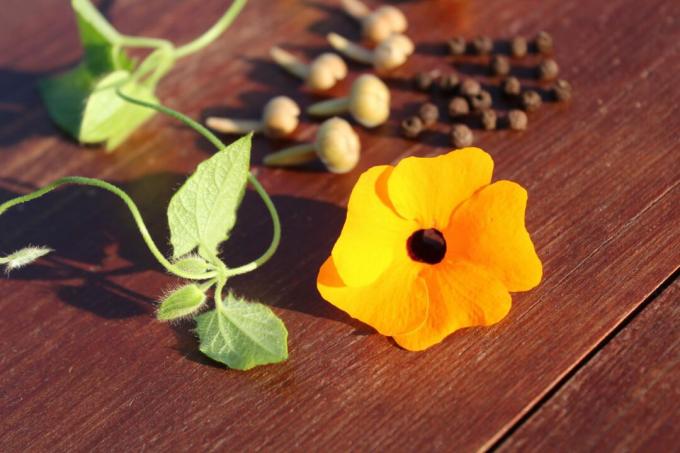
If you do not plant the seeds directly, dry them in a shady place. When storing, ensure a cool temperature of around 10 °C and low humidity. We describe the successful sowing and subsequent transplanting of the young plants in the article Location, care and planting of black-eyed Susanne.
A notice: Since the Thunbergia alata cross-pollinated by insects, the newly obtained seed may not be of the same variety.
Is black-eyed Susan poisonous?
Black-eyed Susan is not poisonous. It is even edible and is therefore ideal for locations that are also accessible for children. The flowers look pretty on salads or in drinks, for example. The climbing plant is also non-toxic to dogs and cats and can be planted without hesitation.

The black-eyed Susanne, along with a few other plants, is ideal as a blooming privacy screen on fences or house walls. The best Climbing plants for fences & walls can be read in our special article.
...and receive concentrated plant knowledge and inspiration directly in your e-mail inbox every Sunday!

